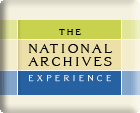July & August 2003 Feature
Patent PuzzlersTurning Records into Discoveries
Stephanie Moore
Office of Museum Programs

Patent Puzzler #1. Larger image.
Answers appear below.
"The Patent System added the fuel of interest to the fire of genius."
—Abraham Lincoln
The Fourth of July is known for parades, fireworks, and now, patents?!
This July 4, as part of the National Archives Independence Day celebration held at Union Station in Washington, DC, the public will get its first taste of the Public Vaults, NARA's new permanent exhibit that takes visitors "behind the scenes" of the National Archives.
The interactive Public Vaults are a major feature of NARA's wider effort to create the National Archives Experience, an effort that will be launched this Constitution Day (September 17) with the rededication of the Rotunda for the Charters of Freedom and continue through the opening of the Public Vaults in fall of 2004.
On July 4, visitors will have a chance to test an early prototype of "Patent Puzzlers," a new concept for a mechanical interactive in the Public Vaults. The interactive game uses reproductions of a variety of NARA's patent drawings to allow visitors of all ages to discover this fascinating group of records while being fun for the whole family.
The game is simple: Look at the drawing, and identify what is being patented. But it is harder than it sounds! Some patent drawings give little clue to the invention pictured.
Try it yourself. Take a look at the drawings on this page. Can you identify the inventions? Children and adults alike will be stumped and fascinated by guessing the names of patent drawings in "Patent Puzzlers."
 Patent Puzzler #2. Larger image. |
 Patent Puzzler #3. Larger image. |
The idea for "Patent Puzzlers" grew out of the desire of the team developing the National Archives Experience to find a fun and interactive way for visitors to learn about some of the millions of patent drawings within the holdings of the National Archives.
The Constitution allowed Congress to give authors and inventors exclusive rights to their writings and discoveries for a limited time. Any person could obtain a patent if they created a new and useful machine, art, design, plant, or article of manufacture. The Patent Act of 1790 established rules for patent submission and a board to oversee the patent process. After the Patent Act of 1836, patent drawings, and if possible, a model would also be required.
For more than 200 years, the U.S. Patent and Trademark Office has been responsible for recording all patents, and many of these, including drawings of inventions such as Alexander Graham Bell's telephone, Cyrus McCormick's reaper, and Thomas Edison's electric lamp are now part of the National Archives within Record Group 241, Records of the Patent and Trademark Office.

Patent Puzzler #4. Larger image.
The Archives preserves more than 2.8 million patent case files, spanning the years of 1836 to 1956. In addition, over 123,000 original and reconstructed patent drawings from 1791 to 1877 are among cartographic and architectural records.
Come discover some of these unique, colorful, and fun drawings at the National Archives' July 4, 2003, celebration at Union Station!
Answers
Patent Puzzler #1: James Barron's attempt to stay cool with his "Fan moved by Mechanism," patented on March 3, 1837.
Patent Puzzler #2: Shoules, Glidden, and Soule's patent drawing for a "Type-writer," patented on June 23, 1868.
Patent Puzzler #3: R. K. Marple's drawing for a staple machine, patented June 23, 1903.
Patent Puzzler #4: An early idea for a fire ladder patented by James Johnson on December 1, 1838.
All drawings are from Record Group 241, Records of the Patent and Trademark Office.
PDF files require the free Adobe Reader.
More information on Adobe Acrobat PDF files is available on our Accessibility page.
